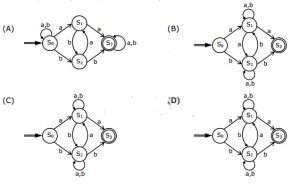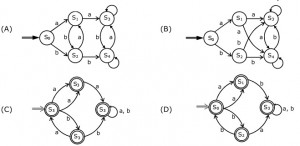Gate IT 2007
Question 61
Consider the following implications relating to functional and multivalued dependencies given below, which may or may not be correct.
i. If A ↠ B and A ↠ C then A → BC
ii. If A → B and A → C then A ↠ BC
iii. If A ↠ BC and A → B then A → C
iv. If A → BC and A → B then A ↠ C
Exactly how many of the above implications are valid?
i. If A ↠ B and A ↠ C then A → BC
ii. If A → B and A → C then A ↠ BC
iii. If A ↠ BC and A → B then A → C
iv. If A → BC and A → B then A ↠ C
Exactly how many of the above implications are valid?
Question 62
Consider the following relation schemas :
- b-Schema = (b-name, b-city, assets)
- a-Schema = (a-num, b-name, bal)
- d-Schema = (c-name, a-number)
Question 63
Consider the following clauses:
i. Not inherently suitable for client authentication.
ii. Not a state sensitive protocol.
iii. Must be operated with more than one server.
iv. Suitable for structured message organization.
v. May need two ports on the serve side for proper operation.
The option that has the maximum number of correct matches is
Question 64
Your are given the following four bytes :
10100011 00110111 11101001 10101011
Which of the following are substrings of the base 64 encoding of the above four bytes ?
Question 65
Question 66
Question 67
Consider the regular expression R = (a + b)* (aa + bb) (a + b)*<br>
Which one of the regular expressions given below defines the same language as defined by the regular expression R?
Question 68
Consider a token ring topology with N stations (numbered 1 to N) running token ring protocol where the stations are equally spaced. When a station gets the token it is allowed to send one frame of fixed size. Ring latency is tp, while the transmission time of a frame is tt. All other latencies can be neglected.
The maximum utilization of the token ring when tt =3 ms, tp = 5 ms, N = 10 is
The maximum utilization of the token ring when tt =3 ms, tp = 5 ms, N = 10 is
Question 69
Consider a token ring topology with N stations (numbered 1 to N) running token ring protocol where the stations are equally spaced. When a station gets the token it is allowed to send one frame of fixed size. Ring latency is tp, while the transmission time of a frame is tt. All other latencies can be neglected.
The maximum utilization of the token ring when tt = 5 ms, tp = 3 ms, N = 15 is :
The maximum utilization of the token ring when tt = 5 ms, tp = 3 ms, N = 15 is :
Question 70
Consider the sequence <xn>, n>= 0 defined by the recurrence relation xn + 1 = c . xn2- 2, where c > 0.
Suppose there exists a non-empty, open interval (a, b) such that for all x0 satisfying a < x0 < b, the sequence converges to a limit. The sequence converges to the value?
There are 80 questions to complete.
Last Updated :
Take a part in the ongoing discussion

